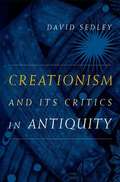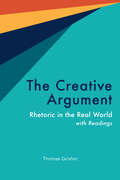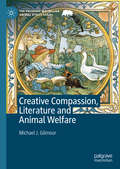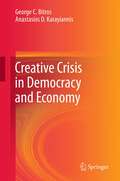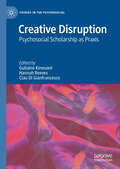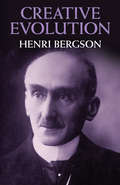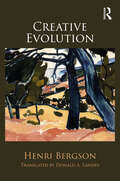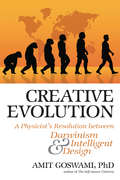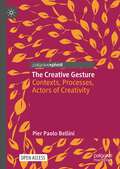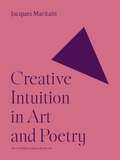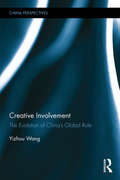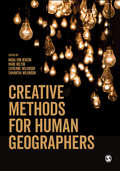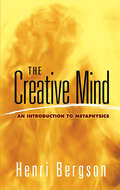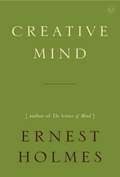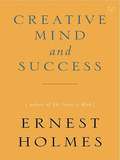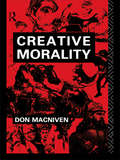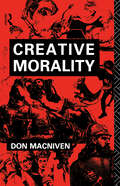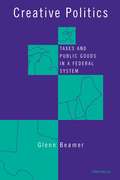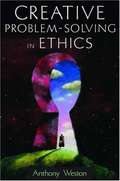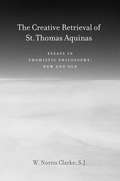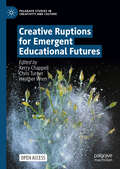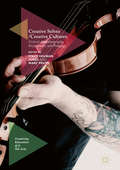- Table View
- List View
Creationism and Its Critics in Antiquity
by David N. SedleyThe world is configured in ways that seem systematically hospitable to life forms, especially the human race. Is this the outcome of divine planning, or simply of the laws of physics? Ancient Greeks and Romans famously disagreed on whether the cosmos was the product of intelligent design or of accident. In Creationism and its Critics in Antiquity, David Sedley examines this question and illuminates new historical perspectives on the pantheon of thinkers who laid the foundations of western philosophy and science. Versions of what today we call the "creationist" option were widely favored by the major thinkers of classical antiquity, including Plato, whose ideas on the subject prepared the ground for Aristotle's celebrated teleology. But Aristotle himself excluded any role for divine intervention, in this respect aligning himself with the anti-creationist lobby, whose most militant members--the atomists--sought to show how a world just like ours would inevitably form by sheer accident, given only the infinity of space and matter. This stimulating study explores seven major thinkers or philosophical movements who were enmeshed in the debate: Anaxagoras, Empedocles, Socrates, Plato, the atomists, Aristotle, and the Stoics. An epilogue considers their debate from the viewpoint of Galen, the great second-century A. D. doctor, who was also a leading voice of creationism. Adapted from Sedley's 2004 Sather Lectures at the University of California, Berkeley, this the first book-length study of an old debate.
The Creative Argument: Rhetoric in the Real World, with Readings
by Thomas GirshinThe Creative Argument sets itself apart from its competitors by presenting a series of compelling works of literary nonfiction that challenge what students think they know about arguments. Each chapter begins with an engaging argument from a work of nonfiction, followed by an in-depth yet accessible analysis of a key aspect of argumentation. Suitable for both courses in argument and first-year writing, the principles and strategies outlined in the text help students become more creative and critical as rhetoricians, both inside the classroom and out.
Creative Compassion, Literature and Animal Welfare (The Palgrave Macmillan Animal Ethics Series)
by Michael J. GilmourThis book examines animal welfare themes in fiction, and considers how authors of the last two centuries undermine dominative attitudes toward the nonhuman. Appearing alongside the emerging humane movements of the nineteenth century and beyond is a kind of storytelling sympathetic to protectionist efforts well-described as a literature of protest. Compassion-inclined tales like the Dolittle adventures by Hugh Lofting educate readers on a wide range of ethical questions, empathize with the vulnerable, and envision peaceful coexistence with other species. Memorable characters like Black Beauty and Beautiful Joe, Ivan the gorilla and Louis the trumpeter swan, Hazel and Cheeta, Mr. Bultitude and Doctor Rat do not merely amuse. They are voices from the margins who speak with moral urgency to those with ears to hear. This broad survey of ethical themes in animal fiction highlights the unique contributions creative writers make toward animal welfare efforts.
Creative Crisis in Democracy and Economy
by George C. Bitros Anastasios D KarayiannisDevelopments across the millennia suggest that, even though democracies and free market economies are continuously challenged by crises and disturbances, such as natural disasters, wars, or technological revolutions, in the countries where they take roots civil liberties deepen and per capita prosperity increases. To substantiate this claim analytically, the authors emphasize the principles that make free markets a sine qua non condition for democracy and study the nature of the relationship between free market institutions and economic growth. By examining the operating principles, outcomes and challenges experienced by contemporary democracies, many lessons are drawn with regard to how governments should act in order to avoid the pitfalls inherently associated with representative democracy. To illustrate the dangers of deviating from these principles, the authors apply their findings to the Greek democracy and economy since the Second World War.
Creative Disruption: Psychosocial Scholarship as Praxis (Studies in the Psychosocial)
by Guilaine Kinouani Hannah Reeves Clau Di GianfrancescoThinking and doing through a diverse set of theories, methodologies and writing registers, this edited collection explores the potential of creative disruption as psychosocial praxis. Moments of disruption – planned and unplanned – are everywhere in the fragile terrain of society, from micro-level gestures of resistance and refusal at the local scale to globally disruptive phenomena such as climate and ecological breakdown and pandemics. The authors of this collection ask instead: how might the disruption we encounter open up junctures for creative and ethical psychosocial engagement? This collection introduces new and emerging voices in psychosocial scholarship from within and beyond academia and the clinic, which brings unique perspectives that have been historically discarded, marginalised or neglected within mainstream academic knowledge production. The contributors examine disruption as a catalyst for discomfort and discontent, drawing from black feminism, whiteness studies, theories of racialisation, queer theory, disability studies, psychoanalysis, postcolonial studies, and more. The authors explore questions of power, knowledge, memory, embodiment and the potential of multidisciplinary approaches in nurturing disruption.
Creative Evolution
by Henri BergsonThe most famous and influential work of distinguished French philosopher Henri Bergson (1859–1941), Creative Evolution features the fullest expression of the philosopher's ideas about the problem of existence, propounding a theory of evolution completely distinct from these of earlier thinkers and scientists.In discussing the meaning of life, Bergson considers the order of nature and the form of intelligence, including the geometrical tendency of the intellect, and examines mechanisms of thought and illusion. In addition, he presents a critique of the idea of immutability and the concept of nothingness, from Plato and Aristotle through the evolutionism of his contemporaries.Bergson's influence on Marcel Proust and other twentieth-century writers renders a grasp of his theories imperative to students of literature as well as philosophy. Historians of science and other readers will also appreciate the importance of this milestone in philosophical and evolutionary thought.
Creative Evolution
by Henri BergsonFirst published in French in 1907, Henri Bergson’s L’évolution créatrice is a scintillating and radical work by one of the great French philosophers of the nineteenth and twentieth centuries. This outstanding new translation, the first for over a hundred years, brings one of Bergson’s most important and ambitious works to a new generation of readers. A sympathetic though critical reader of Darwin, Bergson argues in Creative Evolution against a mechanistic, reductionist view of evolution. For Bergson, all life emerges from a creative, shared impulse, which he famously terms élan vital and which passes like a current through different organisms and generations over time. Whilst this impulse remains as forms of life diverge and multiply, human life is characterized by a distinctive form of consciousness or intellect. Yet as Bergson brilliantly shows, the intellect’s fragmentary and action- oriented nature, which he likens to the cinematograph, means it alone cannot grasp nature’s creativity and invention over time. A major task of Creative Evolution is to reconcile these two elements. For Bergson, the answer famously lies in intuition, which brings instinct and intellect together and takes us “into the very interior of life.” A work of great rigour and imaginative richness that contributed to Bergson winning the Nobel Prize for Literature in 1927, Creative Evolution played an important and controversial role in the trajectory of twentieth-century philosophy and continues to create significant discussion and debate. The philosopher and psychologist William James, who admired Bergson’s work, was writing an introduction to the first English translation of the book before his death in 1910. This new translation includes a foreword by Elizabeth Grosz and a helpful translator’s introduction by Donald Landes. Also translated for the first time are additional notes, articles, reviews and letters on the reception of Creative Evolution in biology, mathematics, and theology. This edition includes fascinating commentaries by philosophers Maurice Merleau-Ponty, Georges Canguilhem, and Gilles Deleuze.
Creative Evolution
by Amit GoswamiBy denying evolution altogether, says quantum physicist Amit Goswani, intelligent design believers fly in the face of scientific data. But the idea of intelligent design does contain substance that neo-Darwinists cannot ignore. Goswani posits that consciousness, not matter, is the primary force in the universe. Biology must come to terms with feeling, meaning, and the purposefulness of life, as well as with the idea of a designer. What's more, reconciling the question of life's purposefulness and the existence of the designer with neo-Darwinism also answers many other difficult questions. The result is a paradigm shift for biology and the vision of a coherent whole that Goswami calls "science within consciousness." In this timely, important book, the author offers clear arguments supported by the findings of quantum physics that represent a major step in resolving controversies between science and religion.
Creative Evolution
by Amit GoswamiBy denying evolution altogether, says quantum physicist Amit Goswani, intelligent design believers fly in the face of scientific data. But the idea of intelligent design does contain substance that neo-Darwinists cannot ignore. Goswani posits that consciousness, not matter, is the primary force in the universe. Biology must come to terms with feeling, meaning, and the purposefulness of life, as well as with the idea of a designer. What's more, reconciling the question of life's purposefulness and the existence of the designer with neo-Darwinism also answers many other difficult questions. The result is a paradigm shift for biology and the vision of a coherent whole that Goswami calls "science within consciousness." In this timely, important book, the author offers clear arguments supported by the findings of quantum physics that represent a major step in resolving controversies between science and religion.
The Creative Gesture: Contexts, Processes, Actors of Creativity (Palgrave Studies in Creativity and Culture)
by Pier Paolo BelliniThis open access book offers a concise overview of the theories constructed within the various human sciences around the theme of creativity as a symbolic capacity to link things together: it manifests itself when the individual endowed with a certain type of intelligence encounters cultural and social conditions that enable them to develop that capacity to the maximum, rather than inhibiting it or diverting it to other fields where it is doomed to failure. Even the most intimate of human expressiveness is considered as a result of an active social relationality. Social dimensions of creativity (evaluation, primary socialization, motivation, leadership) and “creative processes” (creative attitude, creative gesture, divergent thinking, problem-solving capacity, interdisciplinary approach, randomness, algorithmic creativity) are also analysed.The book concludes by evaluating the course taken in the light of the relational theory of society: the development of creativity cannot beconceived outside of self-other relations.This book is the result of a translation done with the help of artificial intelligence. The text has subsequently been revised further by a professional copy editor in order to refine the work stylistically.
Creative Intuition in Art and Poetry (The A. W. Mellon Lectures in the Fine Arts #1)
by Jacques MaritainThe classic work on the sublime interplay between the arts and poeticsThis book explores the rich and complex relationship between art and poetry, shedding invaluable light on what makes each art form unique yet wholly interdependent. Jacques Maritain insists on the part played by the intellect as well as the imagination, showing how poetry has its source in the preconceptual activity of the rational mind. As Maritain argues, intellect is not merely logical and conceptual reason. Rather, it carries on an exceedingly more profound and obscure life, one that is revealed to us as we seek to penetrate the hidden recesses of poetic and artistic activity. Incisive and authoritative, this illuminating book is the product of a lifelong reflection on the meaning of artistic expression in all its varied forms.
Creative Involvement: The Evolution of China's Global Role (China Perspectives)
by Yizhou WangThis book continues the "creative involvement" proposition put forward in Creative Involvement: A New Direction in China's Diplomacy with new cases and stories to enrich its content. It discusses China's global role, and explores its root cause of formation, development stages, and future direction. The main conclusion is that this role is preliminary and incomplete and needs continuous learning and improvement; China standing on the global high ground needs not only hard power but also wisdom and creativity. On research methods and writing approach, firstly, this book follows the philosophy of "practice first", namely, starting from historical experiences, focusing on practical issues, and exploring objectives and clues through case studies. Secondly, the three parts in the book have different sub-themes, but they are subject to the same thinking, that is, how does China advance toward a central role from the marginal edge of contemporary international system, how to develop doctrines or practices for China’s involvement in world affairs, and how to borrow the experiences of others to help China move forward on the global high ground. Combing innovative theoretical idea with practical investigation, this book will not only contribute to contemporary China Diplomatic studies but also appeal to scholars and students of International Relation studies. People who are interested in the rise of China and global governance will also benefit from this book.
Creative Methods for Human Geographers
by Nadia Von Benzon Catherine Wilkinson Mark Holton Samantha WilkinsonIntroducing a broad range of innovative and creative qualitative methods, this accessible book shows you how to use them in research project while providing straightforward advice on how to approach every step of the process, from planning and organisation to writing up and disseminating research. It offers: Demonstration of creative methods using both primary or secondary data. Practical guidance on overcoming common hurdles, such as getting ethical clearance and conducting a risk assessment. Encouragement to reflect critically on the processes involved in research. The authors provide a complete toolkit for conducting research in geography, while ensuring the most cutting-edge methods are unintimidating to the reader.
Creative Methods for Human Geographers
by Nadia Von Benzon Catherine Wilkinson Mark Holton Samantha WilkinsonIntroducing a broad range of innovative and creative qualitative methods, this accessible book shows you how to use them in research project while providing straightforward advice on how to approach every step of the process, from planning and organisation to writing up and disseminating research. It offers: Demonstration of creative methods using both primary or secondary data. Practical guidance on overcoming common hurdles, such as getting ethical clearance and conducting a risk assessment. Encouragement to reflect critically on the processes involved in research. The authors provide a complete toolkit for conducting research in geography, while ensuring the most cutting-edge methods are unintimidating to the reader.
The Creative Mind: An Introduction to Metaphysics (Dover Books On Western Philosophy)
by Henri BergsonThe final published book by Nobel Prize-winning author and philosopher Henri Bergson (1859–1941), La pensée et le mouvant (translated here as The Creative Mind), is a masterly autobiography of his philosophical method. Through essays and lectures written between 1903 and 1923, Bergson retraces how and why he became a philosopher, and crafts a fascinating critique of philosophy itself. Until it leaves its false paths, he demonstrates, philosophy will remain only a wordy dialectic that surmounts false problems.With masterful skill and intensity, Bergson shows that metaphysics and science must be rooted in experience for philosophy to become a genuine search for truth. And in the quest for unanswered questions, the spiritual dimension of human life and the importance of intuition must be emphasized. A source of inspiration for physicists as well as philosophers, Bergson's introduction to metaphysics reveals a philosophy that is always on the move, blending man's spiritual drive with his mastery of the material world.
The Creative Mind: Myths and Mechanisms
by Margaret A. BodenHow is it possible to think new thoughts? What is creativity and can science explain it? And just how did Coleridge dream up the creatures of The Ancient Mariner? When The Creative Mind: Myths and Mechanisms was first published, Margaret A. Boden's bold and provocative exploration of creativity broke new ground. Boden uses examples such as jazz improvisation, chess, story writing, physics, and the music of Mozart, together with computing models from the field of artificial intelligence to uncover the nature of human creativity in the arts. The second edition of The Creative Mind has been updated to include recent developments in artificial intelligence, with a new preface, introduction and conclusion by the author. It is an essential work for anyone interested in the creativity of the human mind.
Creative Mind
by Ernest HolmesThe Pioneering Guide to Success and Self-Mastery Here is the first book by the writer who inspired countless men and women to achieve their greatest potential. It is a simple, straight-to-the-point summary of the principles of affirmative thought that Ernest Holmes made famous in his Science of Mind philosophy. Readers will be unable to look at themselves in the same way after experiencing the potent, overwhelmingly convincing insights and lessons found in this indispensable guide to inner power. "We have within us a power that is greater than anything that we shall ever contact in the outer, a power that can overcome every obstacle in our life and set us sage, satisfied and at peace, healed and prosperous, in a new light, and in a new life." --from Creative Mind
Creative Mind and Success
by Ernest HolmesUse the Practical Power of Creative Thought in Your Life Among Ernest Holmes’s earliest works, Creative Mind and Success is the sage’s consummate guide to the power of positive thought in finance and the workplace, and as a motivating force in living out one’s dreams. "Very deep. ” -Barry Zito, Oakland A’s Pitcher "As we look back, we can take pride that the writings and persona of Dr. Ernest Holmes put him in the forefront of the inspired spiritual leaders of the twentieth century. -Catherine Ponder, author of The Dynamite Laws of Prosperity .
Creative Morality
by Don MacNivenCreative Morality is a philosophical study of moral dilemmas. Western moral thought has relied on two basic ethical perspectives - Utilitarianism and Kantianism - to resolve dilemmas. MacNiven argues that no real progress can be made with modern moral problems unless these tradtions are coherently synthesised. The book deals with diverse topics such as academic honesty, medical confidentiality, terrorism and euthanasia and the hypothetical dilemmas used are based on real life situations so that theory might be tested against reality. Yet the solutions are not definitive because, as MacNiven demonstrates, creativity is an intrinsic characteristic of moral thought.
Creative Morality
by Don MacNivenCreative Morality is a philosophical study of moral dilemmas. Western moral thought has relied on two basic ethical perspectives - Utilitarianism and Kantianism - to resolve dilemmas. MacNiven argues that no real progress can be made with modern moral problems unless these tradtions are coherently synthesised. The book deals with diverse topics such as academic honesty, medical confidentiality, terrorism and euthanasia and the hypothetical dilemmas used are based on real life situations so that theory might be tested against reality. Yet the solutions are not definitive because, as MacNiven demonstrates, creativity is an intrinsic characteristic of moral thought.
Creative Politics
by Glenn BeamerState legislators are constantly making tradeoffs between changing taxes and providing public services. Not only must they reconcile their own policy preferences with the preferences of their constituents, but they must consider the impact of actions taken by both the federal government and competing states. Glenn Beamer uses a series of in-depth case studies in eleven states to show how legislators made decisions dealing with taxation, economic development, education financing, and Medicaid. Beamer identifies six factors that influence legislators' decisions: accountability, dependability, equity, obscurability, and horizontal and vertical transferability. Within the context created by citizen demands, intergovernmental politics, policy histories, court interventions, and state constitutions, this study analyzes how legislators employ these principles to develop and enact policies. In addition to modeling state politics within the context of federalism, Creative Politics, reflecting the author's extensive interviews with legislators, is novel in its focus on politicians' views about public services, the strategies to finance them, and efforts to develop and maintain political support for them. This book will be of interest to students and scholars of political science, economics, and public administration, and, more specifically, of federalism, state politics and policy, and legislative decision-making.
Creative Problem-Solving In Ethics
by Anthony WestonA readable and insightful guide to ethical dilemmas.
The Creative Retrieval of Saint Thomas Aquinas: Essays in Thomistic Philosophy, New and Old
by W. Norris Clarke S.J.W. Norris Clarke has chosen the fifteen essays in this collection, five of which appear here for the first time, as the most significant of the more than seventy he has written over the course of a long career. Clarke is known for his development of a Thomistic personalism. To be a person, according to Saint Thomas, is to take conscious self-possession of one's own being, to be master of oneself. But our incarnate mode of being human involves living in a body whose life unfolds across time, and is inevitably dispersed across time. If we wish to know fully who we are, we need to assimilate and integrate this dispersal, so that our lives become a coherent story. In addition to the existentialist thought of Etienne Gilson and others, Clarke draws on the Neoplatonic dimension of participation. Existence as act and participation have been the central pillars of his metaphysical thought, especially in its unique manifestation in the human person.The essays collected here cover a wide range of philosophical, ethical, religious, and aesthetic topics. Through them sounds a very personal voice, one that has inspired generations of students and scholars.
Creative Ruptions for Emergent Educational Futures (Palgrave Studies in Creativity and Culture)
by Chris Turner Kerry Chappell Heather WrenThis open access book aims to show how creative ruptions – disturbances or commotions - can lead to the emergence of ethical, care-ful educational futures. Grounded in empirical and theoretical research undertaken from posthuman, decolonial, new materialist and feminist perspectives, this edited volume questions historical and current assumptions as to how education is structured and enacted, and provides examples and tools illustrating how to create and work with creative ruptions. Under the guidance of an experienced editorial team, the authors demonstrate how creative ruptions can respond to various wicked problems through the design and enactment of transformative pedagogies and accompanying research. Including consideration of how we can grow our emotional repertoires from anxiety to include hope and courage, the book explores how creativity might expand the horizons of personal, social and political possibility that take shape within – and ultimately determine – education and its futures.Offering theoretically driven and practically grounded transdisciplinary examples of alternative educational futures, this volume is an ideal reading for those interested in the intersecting fields of Possibilities Studies in Education, Creativity in Education, Educational Futures, Pedagogy, and related disciplines.
Creative Selves / Creative Cultures: Critical Autoethnography, Performance, and Pedagogy (Creativity, Education and the Arts)
by Stacy Holman Jones Marc PruynThis book addresses and demonstrates the importance of critical approaches to autoethnography, particularly the commitment that such approaches make to theorizing the personal and to creating work that embodies a social justice ethos. Arts-based and practice-led approaches to this work allow the explanatory power of critical theory to be linked with creative, aesthetically engaging, and personal examples of the ideas at work. By making use of personal stories, critical autoethnography also allows for commenting on, critiquing, and transforming damaging and unjust cultural beliefs and practices by questioning and problematizing the relationships of power that are bound up in these selves, cultures and practices. The essays in this volume provide readers with work that demonstrates how critical autoethnography offers researchers and scholars across multiple disciplines a method for creatively putting critical theory into action. The book will be vital reading for students, researchers and scholars working in the fields of education, communication studies, sociology and cultural anthropology, and the performing arts.
